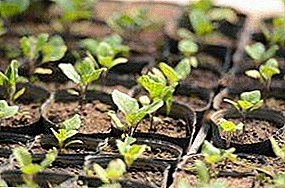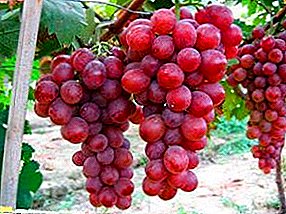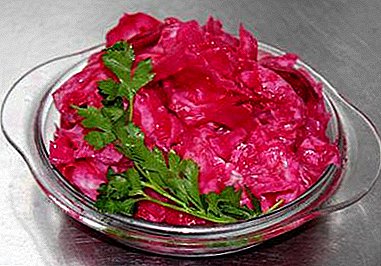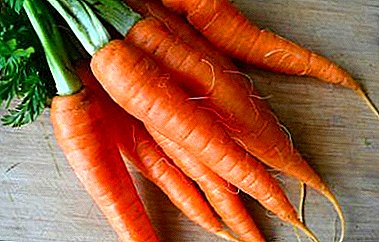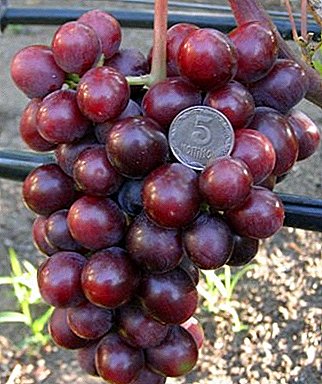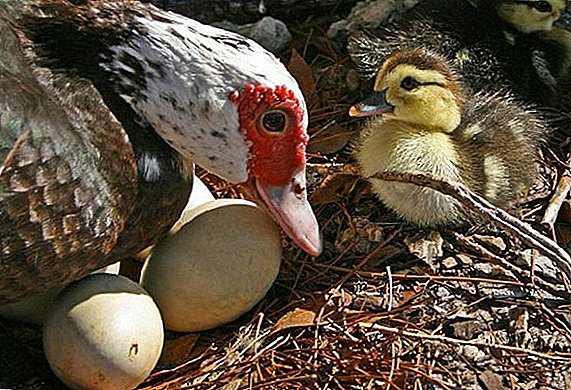
Carrots - the favorite root of any gardener. Enjoy sweet and juicy carrots like both children and adults.
The secret of the popularity of this vegetable lies not only in taste, but also in vitamin properties. Rich in fructose and carotene, carrots have long been fond of and have firmly entered the diet of the inhabitants of our country.
This article discusses in detail the variety of carrots Vitamin 6. Detailed recommendations for its cultivation at home are given.
Breeding history
Vitamin 6 carrot variety was created at the Research Institute of Vegetable Economy by crossing Amsterdam, Nantes foreign breeding varieties and Tushon. Selection was carried out by hybridization of a variety with a high content of beta-carotene.
What is the difference from other species?
Vitamin 6 is distinguished from other types of carrot by a number of features.:
- well kept;
- has excellent taste and aroma;
- cylindrical shape with a blunt end;
- high content of carotene;
- bright color;
- high yield;
- resistance to tsvetushnosti.
Advantages and disadvantages
 This variety has many advantages that distinguish it from others:
This variety has many advantages that distinguish it from others:
- frost resistance and unpretentiousness to climatic conditions;
- good yield;
- undemanding to storage conditions;
- even, cylindrical shaped roots with shallow eyes;
- taste qualities;
- high content of fructose and beta carotene.
The disadvantages of carrots Vitamin 6 can be attributed:
- prone to disease;
- Demanding to care.
Detailed characteristics and description of the variety
- Appearance. The variety of carrot Vitamin 6 has fruits of oblong cylindrical shape with a rounded tip. Most often root crops turn out equal, without bends and deformation. The color of the fruit is bright orange with a red tinge. The core of this variety is star-shaped.
- Amount of fructose and beta carotene. Vitamin 6 carrot is famous for its high content of vitamins, fructose and beta-carotene. Content per 100 g of carrots: fructose - 17-22 mg, carotene - 7-10%.
- Sowing time. The optimal spring sowing time for this variety is the second half of April - the beginning of May. Also Vitamin 6 can be planted before winter, in this case, the harvest can be collected in July. It should be borne in mind that such fruits cannot be stored, only used for food.
- Seed germination. Seed germination depends not only on their quality and firm, but also on the type of carrot. Vitamin 6 variety is characterized by good seed germination, almost 100%.
- The average weight of 1 root. The weight of one carrot root varies in the range of 70-170 g. Often there are specimens weighing 200 g.
- What is the yield of 1 ha. Gardeners and farmers love this variety of carrots for high yields. With proper care and watering, from one hectare of land harvesting reaches 1 centner of root crops.
- Assignment grade and keeping quality. Vitamin Carrot is a versatile variety, great for canning, freezing and for winter stocks. Due to its good keeping quality, it is able to be stored and delight with excellent taste throughout the winter. Also, this variety is eaten raw, used for baby food.
- Growing regions (Ural, Siberia, etc.). The most favorable regions for growing Vitamin 6 carrots are all regions of Russia, except for the North Caucasus region. From neighboring countries, this variety is recommended for cultivation in Lithuania, Latvia, Kazakhstan and Ukraine.
- Where it is recommended to grow. Vitamin 6 carrot has good resistance to cold weather and even frost. Therefore, it is recommended to grow it from early spring on open ground, for example, on the garden plot. Planting in the greenhouse is inappropriate for this variety.
- Disease resistance. This variety is quite susceptible to various diseases and pest attacks. To minimize the likelihood of disease, you should annually change the place for beds with carrots. The best predecessor will be potatoes. It is not recommended to plant carrots where tomatoes, parsley, dill, beans or fennel grew.
- Ripening. Carrot Vitamin 6 is considered mid-season. Harvest can be collected in 3.5-4 months after sowing.
- What kind of soil prefers. For the cultivation of this variety will be the most favorable mineral or peat soils. The pH should not exceed 7. In addition, the soil should be light, loose, so that the carrots grow large and long.
- Frost resistance. In regions such as Siberia and the Urals, frost on the soil is not uncommon. Frosty days are observed both in late spring and in early autumn. Vitamin 6 carrots are quite resistant to frosts, withstand temperatures of 0 ° C ... -3 ° C.
Growing up

- Experienced gardeners recommend planting this carrot immediately after snow melts for early harvest. At the same time, the soil temperature should be at least + 8 ° С. For winter storage, you can make crops until the end of May.
- Before planting, the soil should be enriched with organic fertilizers: rotted manure, wood ash or compost.
- The depth of the grooves for sowing should be 1.5-2 cm, the distance between the rows - 17-20 cm. The optimum temperature for seed germination is from + 15 ° С. Sprouts appear in 10-12 days.
- For friendly shoots and a rich harvest, it is necessary to periodically loosen the soil. Carrot Vitamin 6 loves abundant watering throughout the summer. When moisture is sufficient, the fruits grow juicy and large. However, care should be taken that water does not stagnate on the soil.
- If planting was done in the usual way, the shoots must be thinned. The first thinning should be done, leaving 2 cm between sprouts, the second - at a distance of 4 cm.
Harvesting and storage
Subject to the observance of the necessary parameters, Vitamin 6 should be stored for a long time, after lying all winter, it will not lose its taste. It is possible to store these useful root crops both in a cellar, and on a loggia in the warmed box. Before laying vegetables for winter storage, they must be dried in the open air or in a ventilated room.
Diseases and pests
 Diseases and pests can be a real disaster for gardeners who grow carrots in their beds. The most common diseases of the Vitamin 6 variety are:
Diseases and pests can be a real disaster for gardeners who grow carrots in their beds. The most common diseases of the Vitamin 6 variety are:
- fomoz;
- rhizoctoniosis;
- bacterial rot.
The most dangerous and common pests of the variety:
- carrot patch;
- slugs;
- wireworm.
Various growing problems and solutions
When cultivating these healthy root vegetables, gardeners often encounter various difficulties. Let us examine the most common problems and possible solutions.
| Symptom of a problem | Cause of the problem | Decision |
| Early twisting and discoloration of carrot leaves to burgundy | Lack of potassium | Apply potash fertilizer |
| The appearance of many hairs on the root | Too abundant watering | Keep watering to a minimum after the second thinning |
| Darkening of the core | Lack of manganese and barium | After the appearance of 5-6 leaf carrots should be treated with microelements (spray) |
| Root crops have become many-tailed | Excess fertilization containing ash, lime or nitrogen | Reduce the amount of nitrogen fertilizer, do not apply ash to the soil |
| Cracking fruit | Excess moisture or nitrogen | Reduce watering and stop applying nitrogen fertilizer to the soil. |
Similar varieties
Varieties similar in their properties to carrots Vitamin 6:
- Losinoostrovskaya - bright, sweet root vegetables for universal use.
- Nantes - mid-season, productive variety.
- Shantane - fruitful, maturing variety with high taste qualities.
- Tushon - a carrot-like type of carrot resistant to color.
- The emperor - cylindrical root crops with a high content of carotene.
It is difficult to overestimate all the advantages of the Vitamin 6 carrot variety. Thanks to its even, cylindrical shape, this carrot is convenient in cooking. You can eat raw, add to food, freeze or put in winter storage. Yielding, lying, unusually tasty and healthy, it will immediately become the favorite treat of any family.


